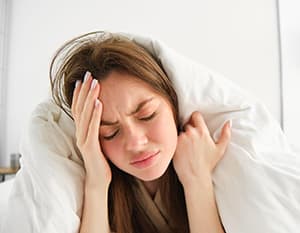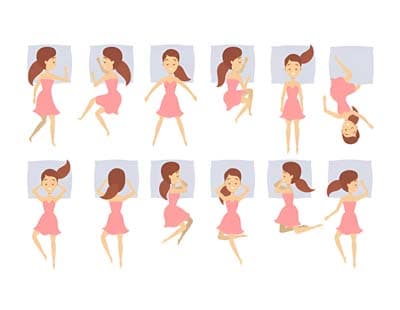Do you wake up in pain in the morning more often? You might be sleeping wrong. And that is about more than just lousy posture; it can also be the inadequate sleep setup in your bed. Now, what is a sleep setup? It’s just the pillow you use, and the mattress you sleep in, and it can also constitute the kind of sleeper you are.
What’s the best way to get rid of back pain from sleep? In conjunction with a comfortable mattress, finding a supportive pillow for back pain can help alleviate a painful back, neck, and shoulder pain.
Best Pillow for Back Pain
Suppose one part of your body is misaligned. In that case, it will have a cascading effect on other body parts as the muscles respond to the unusual phenomena and overcompensate for the affected area. So, what is the solution?
A supportive yet comfortable pillow for backache that will align your head and cradle your neck to maintain optimum body balance and avoid extra pressure on the muscles. A back pillow for pain will help you with back strain and neck stiffness, letting you sleep like a baby!
Finding the best pillow greatly depends on your regular body posture and what makes you the most comfortable while sleeping. However, there are tips and tricks you can apply out of the bag to help speed the process. Different pillow types will have different effects on your sleep quality, so let’s explore each one.
Before buying a backache pillow, check the following points:
- Pillow fabric
- Pillow loft or height
- Pillow size and shape
- Pillow firmness
Now, let’s get you that pillow of your dreams! Below, we have listed some very popular categories of pillows for back problems that will quickly relieve your back pain.
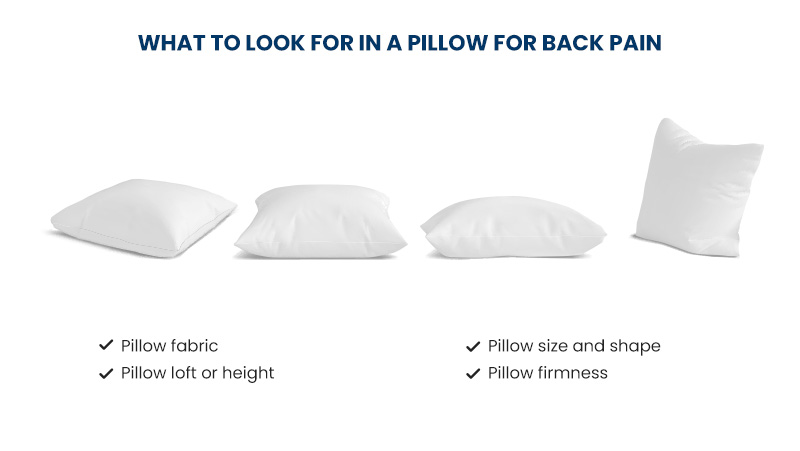
Memory Foam Pillows
When you experience back pain, your lower back takes the hit. In such a scenario, memory foam pillows will be your wisest choice. Side and back sleepers can comfort themselves with a foam pillow's sturdy yet moldable support, keeping their head and neck at an appropriately balanced height.
Pick a back pillow for back pain with breathable layers of memory foam and cooling properties. These pillows offer as much support as needed to align your head and neck. Sleeping with such pillows will significantly prevent extra muscle stress and reduce back pain.
Pillows for Lumbar Support
It is a read and revised notion that many types of back pain root from an unhealthy curve in the spine. Pillows that you place only against the lower part of your back are designed to offer adequate lumbar support. They help you maintain the proper alignment of your back. This can help some people minimize their pain.
Cut-out Pillows
Do not worry; it is much better and more effective than it sounds. A pillow with a cut-out design may help you solve your spine problems. Some people find thick pillows supportive for maintaining their spine's natural curve, but for some, they cause discomfort when they push the lower back slightly forward.
A cut-out pillow helps with the same. The cut-out design makes room for the tissues that collect at the top of your hips and the bottom of your back when you sit. Such a design keeps your pillow from pushing your lower back forward while supporting the spine curve.
Backrest Pillow
A backrest or back support pillow typically comes in a wedge or contour shape designed to provide firm back support. Such pillows are made with armrests and an extra shape for neck support. Backrest pillows are most handy in reducing back pain as they balance your entire body, which prevents unnecessary stress on the muscles.
Side Sleepers also benefit from a backrest pillow, as it provides excellent between-the-knee support. This relieves hip pain and keeps the body properly aligned.
Latex Pillows
If you are squirmy and experience a lot of tossing and turning while sleeping, then the loft or height of your pillow is to blame. Latex pillows with different kinds of fillings usually come with customizable options. You can adjust the height according to your preferences and comfort. Adjusted support will cradle your head and neck, thereby reducing back aches.
Latex is known for its cooling properties, so if you are a hot sleeper, this is bliss. A cooler temperature will ensure sound sleep, and you can get lost in dreamland without any interruptions.
Down or Down-Alternative Pillows
Down pillows are super fluffy and mushy, so they might not provide as firm a support as memory foam pillows, but they are still excellent for customized support for your back and joints.
In fact, for back and stomach sleepers, down pillows can easily be compressed and used under the pelvis for the perfect lumbar support. What else could one ask for a long, healthy, restful sleep?
Types of Back Pain
Early discovery about what kind of back or lower back you have will allow you to figure out how to treat it accordingly. Majorly when we talk about severe levels of back pain issues, we are talking about the following categories:
- Acute - Chronic
Acute Back Pain
Acute back pain is generally categorized as short-term. If you have acute back pain, it most likely started unexpectedly. Anxiety, intense physical activity, clumsy motions, or incorrect lifting techniques can all lead to severe back discomfort.
Acute back pain is most frequently diagnosed. It can last up to six weeks. Furthermore, the underlying source of the discomfort is typically not a significant or persistent issue.
Chronic Back Pain
Now, when we say chronic, we mean long-term distress. Because the symptoms of chronic pain are severe enough to affect your mobility, quality of life and health over an extended period is considered a severe condition.
Although it can strike without warning, persistent back pain often develops gradually over more than six weeks. Recurrent back pain is another term for chronic back pain that occasionally disappears but returns regularly.
Although a recent accident may produce chronic pain, underlying medical issues are typically the actual cause. One of the most common reasons is muscle deconditioning, characterized by losing back strength and stability.
Other factors, such as poor posture, improper lifting techniques, obesity, and lack of exercise, can also contribute to back pain.
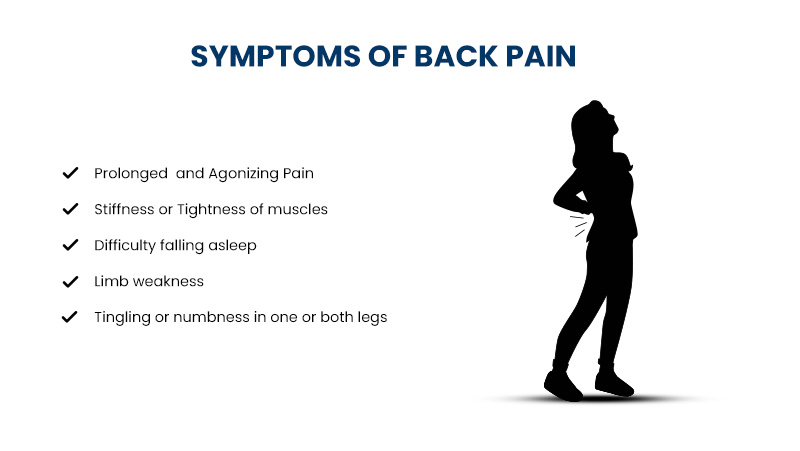
Symptoms of Back Pain
The symptoms of acute and chronic back pain are quite similar. The only difference between the two is the duration. As we discussed earlier, acute back pain is short-term, while chronic is long-term and requires sincere medical attention.
- Excruciating, scorching, or unbearable pain that doesn't go away or comes back despite the use of over-the-counter drugs, home remedies, massage, or physical therapy
- Consistent stiffness or tightness, particularly after extended durations of lying down, sitting, or standing
- Difficulty falling asleep
- Limb weakness, characterized by tingling or numbness in one or both legs
What Causes Back Pain During Sleep?
If you get out of bed with more back pain in the morning than the night before, your sleep setup is to blame. Most people with back pain feel it most in their lower back.
Many joints, muscles, and spinal disks interact in this sensitive body area. Pressure and misalignment of the spine can place high-stress levels on the back and overall body balance while sleeping.
Unsupportive Sleeping Position
If you experience lower back pain every morning after you go to bed, your sleeping position may be the cause. Back pain might result from sleeping in an unsupportive position, which puts more strain on your spine.
Stomach Sleeping
Stomach sleeping can twist your neck out of line with the rest of your spine. Depending on how firm your mattress is, your lower abdomen may descend more than the rest of your spine, pulling your back out of alignment.
In either case, you may be more likely to wake up with lower back pain if you sleep in this position. To help prevent this misalignment, try sleeping on your stomach with a small pillow beneath your lower belly and no head pillow.
Back Sleeping
Although resting on your back facilitates maintaining a straight spine, failing to support the natural curve of your spine can still result in back pain. According to one study, this sleeping posture actually increases your risk of lower back pain. Consider putting a pillow under your knees to reduce your risk and avoid pain.
Wrong Mattress
If you are sleeping on an outdated, unsupportive mattress, your sleep position can only do so much to help reduce lower back discomfort in the morning. If you've owned it for more than five years, it could be time to replace it.
In one study, users replaced their worn-out, 10-year-old mattresses with brand-new ones. Over the next month, both their back discomfort and the quality of their sleep improved each week.
Even if your mattress is brand-new, it might not match you or your favorite sleeping position. It cannot provide adequate support since it is too soft or rigid. Firm mattresses typically do a better job of reducing lower back discomfort than medium-firm mattresses.
Pregnancy
Back discomfort is a typical pregnancy symptom. Although it usually starts in the second or third trimester, it can occur as early as the first four weeks of pregnancy. Some pregnant women experience worsening back discomfort as they sleep, which might wake them up. However, following delivery, this kind of back pain usually goes away.
Stretching frequently and applying a warm compress to the back can help reduce lower back pain during pregnancy. Lower back discomfort can be avoided using leg strength to help you stand up from the bed rather than your back muscles.
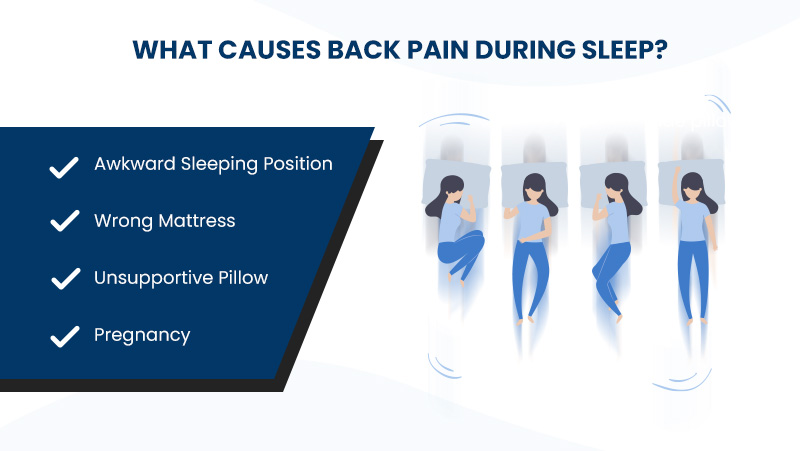
Reasons for Morning Lower Back Pain
Many additional variables could be involved in lower back pain in the morning. Other illnesses and lifestyle choices, such as the following, can also result in lower back pain:
- Endometriosis and arthritis
- kidney stones
- Mental health issues such as depression and anxiety
- Jobs involving a lot of pushing, tugging, or heavy lifting
- advanced age
- The osteoporosis
- bodily harm
- Unfitness
- Consuming tobacco
- spinal cord, issues such as ruptured discs, spinal stenosis, and sciatica
- Tension Tumors
- Gaining weight
Is Back Pain Highly Common?
Yes, back pain is widespread and one of the most prevalent medical problems globally. According to the Global Burden of Disease Study 2017, lower back pain is the leading cause of disability worldwide.
It affects people of all ages, from adolescents to older people. Back pain is the most prevalent cause of disability among American workers, accounting for 2% of all cases of incapacity to perform everyday duties.
How to Sleep with Your Pillow?
Let’s see what other things we can do to increase back comfort. Well, you can do a few tricks with the pillow to wake you up with a smile.
Sleeping with Pillow Between Your Knees
Often, side sleepers' knees fall together while sleeping, which can result in a misaligned spine. This posture might feel comfortable for a while, but after a few hours, it will start creating stress on the spine, especially if your mattress isn’t that supportive.
Keeping a pillow between your legs will help you keep your back properly aligned. Sleeping with your pillow like this benefits you in many ways. It maintains accurate back posture, minimizes the chances of back pain, and also reduces hip and sciatica pain.
Sleeping with Pillow Under Your Knees
This technique was invented for back sleepers. You place the pillow underneath your knees to maintain your posture while sleeping. Sleeping like this will allow you to maintain the natural curve of your lower back and properly distribute your body weight on the bed.
Sleeping with Pillow Under Your Stomach
As you might have known by the name, this one is ideal for stomach sleepers. Keeping the pillow under your pelvis or thighs can significantly reduce pressure on the spine.
The posture may sound funny, but it effectively prevents nerve strain and treats lower back pain. If you are a stomach sleeper, try this today!
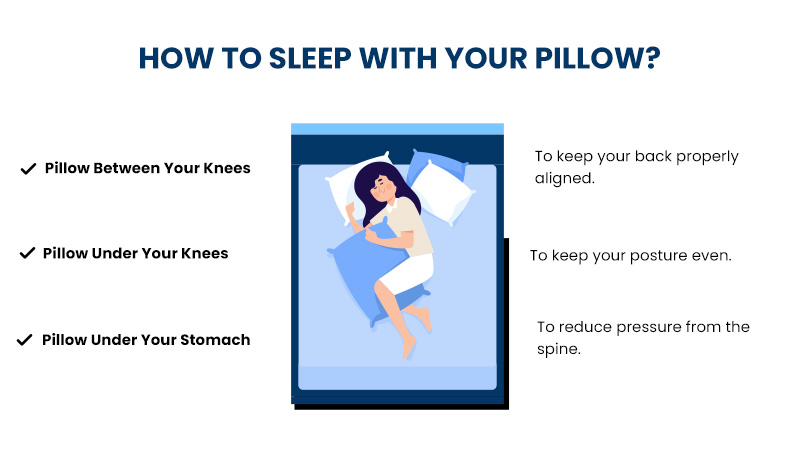
Who is Prone to Back Pain?
The likelihood of developing back discomfort increases with age. Additionally, you have a greater risk if you:
- Avoid exercising.
- They already have arthritis or some form of cancer.
- Are overweight.
- Raise using your back, not your legs.
- Experience despair or anxiousness.
- Use tobacco goods or smoke.
When Should You Seek Medical Care?
If you have back discomfort, you should consult a doctor if
- Resting does not lessen the intense discomfort.
- The discomfort affects one or both legs, which is particularly bad if it goes below the knee.
- One or both of your legs feel weak, numb, or tingling.
- You struggle to maintain bladder or bowel control.
- Chills, a fever, or an inexplicable weight loss accompany the pain.
- You have had recent trauma, osteoporosis, or cancer in the past.
- The discomfort impedes your regular activities and lasts more than a few weeks.
Severe or persistent back pain may indicate an underlying medical problem that needs to be evaluated and treated by a healthcare provider right away.
Final Thoughts
Getting the right pillow doesn’t magically cure your back pain overnight. Nothing can do that. But it will offer you the proper support your back needs. If you are still with us, you must have read everything a supportive pillow can do for you. You just need to get started.
The Eli & Elm pillow provides support for your neck, back, and shoulder. You’ll be relieved every morning when you roll out of bed painlessly. The shredded latex filling of the Eli & Elm side sleeper pillow allows your back to find comfort without being uneasy while sleeping.
The pillow's cooling properties are the cherry on top. Whether you are a hot sleeper or prone to tossing on the bed, our pillow keeps you at an optimum temperature, providing you with the most sound sleep ever.
Sources:
The Lancet Rheumatology: The global epidemic of low back pain
360 Orthopedics: Why Is Back Pain So Common
UT Southwestern Medical Centre: 5 signs your back pain might be an emergency













